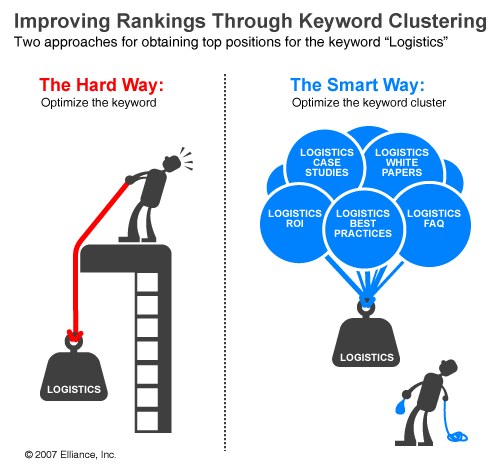If you’re someone who loves writing as much as I do, sometimes it’s easy to be stubborn and fall into the “I’m a WRITER dammit – I write WHAT I want, WHEN I want” mindset. And while it is important to use some common sense and creativity, and write about whatever strikes your fancy at that particular moment in time (as long as it’s relevant to your industry of course), it’s equally important to look at the data side of things to see how your site is performing, where it could be doing better, and how content can help plug any leaky holes in your conversion funnel. It’s actually kind of exciting. Think of yourself as a detective, trawling Google Analytics for clues, and then coming up with elaborate content plans on how to solve the mystery of why your traffic hasn’t increased as much as you would have liked it to… Pretend you’re Jessica Jones. Whatever floats your boat.
Anyway, perhaps you’ve been mostly relying on your intuition and your own creative talents to inform your decisions when it comes to things like blog post topics and your overall content strategy, but would like to start delving deeper into the data-driven side of content marketing. Or maybe you’re looking for a few new ways to look at the data you’ve already been analysing. Whatever your reasons, we’re hoping today’s blog post will help. We’ve put together a list of three data sources you can look at when formulating or updating your content marketing strategy.
Good news! You can still write what you want – you just need to use a few numbers to back it up.
1. Analytics and User Behaviour Data
The first data source we rely on frequently of course is our good friend Google Analytics. A good content marketer will be able to look at the numbers in analytics and immediately see words forming in their minds. High bounce rate on one of your landing pages? Then maybe you need to beef it up a bit with some different compelling content, or even a video. Low traffic to your blog? Then maybe you need to integrate a solid social media (or social ads) campaign. Don’t forget to check out the Analytics solutions gallery for custom-built reports to make your life approximately 1,000% easier.
Examples of a few things you can look at in Analytics include:
- Current traffic on your existing posts – Looking at your results in the ‘Content Drilldown’ view, which of your blog posts have gotten the most views to date? Is there a clear standout? Did a funny video post get 4 times more views than a simple how-to post? Looking at how your existing content is performing can tell you which types or genres of posts do better than others, so that you can create more of what your audience is already loving.
- Time lag to converting – How long on average does it take people to convert from the first time they visit your site? Does it take a fairly long time (even if your product or service tends to have a fairly short decision-making and buying cycle)? Is there enough content on your site explaining to people what your product or service is about to allow them to make an informed decision? Do you need to create a lead capture piece of content to encourage people to convert before they leave (and potentially never come back again)?
- Bounce rate – What percentage of people view only one page and then leave? Don’t just look at your home page – Is your bounce rate particularly high on more than a few of your content pages? Do you have enough juicy content on all pages of your site to entice people to hang around for longer? What’s a good bounce rate you ask? We like to think it’s more important to look at the averages for your site, and aim to improve that gradually and continually.
The list can go on and on, but Marketing Land covers off a few more aspects of Analytics data you can look at. You can also look at Interests Reports in Analytics, and we’ve covered off the instructions on how to do this in a previous blog post.
2. Keyword Data
Any good SEO will know that it’s obviously important to identify what people search for when they’re looking for your product or service, and what content you should be putting out there to answer these queries. Apart from the good old keyword planner, there are a few other tools out there that can help you pull data from Google Autocomplete for longer-tail phrases and questions, which often make great blog post titles or page titles for your static content (Note: Google shut down their Autocomplete API in August this year, so we’re not sure for how long these tools will keep working – After that we’ll have to get even more creative.)
But search volumes aren’t the be all and end all – the second part of the keyword data equation is of course monitoring your keyword rankings. But don’t just look at your rankings in one big long list. It’s important to segment your keywords by service or product, and if you or your client has multiple locations around the country or world, then segment by locations as well.
We regularly segment our keywords into clusters our tracking systems so that we can closely keep an eye on which products, services or locations are ranking well, and which ones aren’t doing so well. This allows us to put more attention into those areas that need a boost, rankings wise, whether that’s a few more blog posts for that specific area, or whether it’s building more high quality links to the relevant page of the site (or creating one in the first place).

A recent example comes from a hair salon client of ours, Franck Provost Paris, who has 12 locations across Sydney and one in Melbourne. By continually monitoring how the website is ranking for search terms related to each suburb, we were able to identify which suburbs needed a boost through content creation, and link building to the specific salon pages.
3. Trends Data
Looking at trend data is less strictly numbers, and more around identifying what’s happening out there in the world of the internet and staying relevant with your content. You can easily look at what’s being talked about in the news, on social, or on tools like Buzzsumo. But it’s also about being ahead of the trends as well – So we like to experiment with tools that show us potential trends which are about to take off. One tool we’re experimenting with at the moment, and that we’ve mentioned in blog posts before, is Spike, by a small Dublin based company called Newswhip. It shows you certain topics and pieces of content like videos or articles, that are ABOUT to explode in popularity, so that you can catch it and “break the story” before everyone else does.
So if there’s a relevant viral video for example which is just starting to get traction but hasn’t QUITE taken off just yet, you can be one of the first to share that, along with a blog post on your company website, and seed it out.
So one idea recently hatched and implemented by our content marketing topgun Scott Pittman for one of our clients was finding a funny video of Ryan Reynolds trying to put together IKEA furniture (which hadn’t quite gone “viral” yet), then posting it on the blog of one of our clients in the home building industry. The post got a really great response – about 50% more views for that post than any other post on the blog.
It’s important to remember with data though that it’s not the be all and end all. I think you have to also just be involved and aware of what’s going on in the world as well, and just kind of use a bit of common sense and creativity – Something that all good content marketers today need.
What other sources of data do you look at when formulating or adjusting your content strategy, or even thinking about what to write about in your next blog post?
